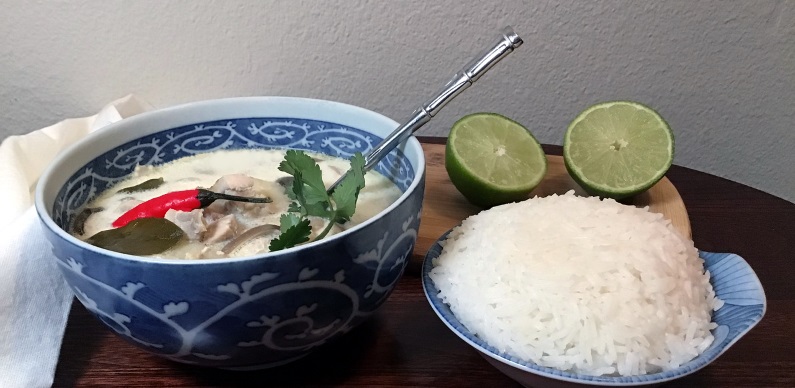We return to Thailand for this month's recipe and one of my favorite soups, Tom Kha. This delicious soup is a standard offering in nearly all Thai restaurants; once you gather all the proper ingredients, it is very easy to prepare.

Tom Kha is very similar to Tom Yum soup; the major difference is that Tom Kha has coconut milk making it thicker and creamier, and Tom Yum is the spicier of the two soups. Tom translates as "boiled", and "kha" is the Thai word for the ginger-like root known as galangal. Some American cooks substitute ginger for the galangal, and some recipes use both. If you use chicken in the soup, it is called Tom Kha Kai (sometimes transliterated: Tom Kha Gai), and if you use shrimp instead it is called Tom Kha Goong. The choice of which to make is yours—you can even use a white fish, and then it would be called Tom Kha Pla. And now you also know the Thai words for boiled, chicken, shrimp, fish and galangal! If you use vegetable stock and cubed tofu, you can even make a tasty vegetarian soup.
In Thailand, soup is eaten somewhat differently than the way most Americans eat soup. It is not a meal starter or appetizer; soup is served along with everything else. Thais typically use spoons rather than either chopsticks or forks, and also soup is frequently not consumed strait from the soup bowl but is, instead, spooned over rice first. Regardless of the meal, a bowl of rice is a de rigueur complement to Tom Kha. But, of course, there is nothing stopping you from enjoying Tom Kha directly from the bowl. People who live in Southern Thailand use more coconut milk in their meals compared to those who live further north, but curiously Tom Kha soup is believed to have its origins in the North and may have been introduced from Laos where the soup is also found. A primary difference between Tom Kha in Thailand is the use of coriander leaves, whereas in Laos, dill is more common.
Tom Kha requires several ingredients that are not commonly found in regular grocery stores although most Asian markets (we shop at 99 Ranch) will have them. These include galangal root, Thai chilies, lemongrass stalk, Fish sauce (Nom Pla), and Kaffir lime leaves. You can substitute regular cane sdsugar for the palm sugar in this recipe, but there is a slight difference in taste. Authentically you would leave the pieces of lemongrass, lime leaves, and galangal slices in the soup when it is served, but they are all for flavoring, not for eating directly. So either warn any guests regarding this, or remove these bits before serving. Some cooks slice the lime leaves very thinly, chop the lemongrass or grind the galangal to get around this problem, but that is not really necessary because the flavors will infuse into the soup just fine.
What you choose to be your main protein source will determine the type of stock you use. If you use chicken, use chicken stock, fish use fish stock and for tofu Tom Kha use vegetable stock. Again, a very popular version of this soup is made with shrimp and making shrimp stock couldn't be easier. To do this, it is best to buy shrimp with heads and shells. Here are the steps. 1. De-head and shell the shrimp 2. Rinse the heads and shells 3. Dry-fry the heads and shells for a minute or two turning frequently (note: in Thailand, this is not normally done but it does increase the flavor) 4. Add 2 cups water. Boil the shells for 5 minutes. Strain the broth in a strainer, pushing down on the shells to get all the liquid. A nice thing about making shrimp stock is that it is completely unnecessary to boil the shells and heads for more than 5 minutes—indeed the folks at American Test Kitchen claim that because the flavor compounds in shrimp shells and heads are so volatile, shorter is better than longer. However, many well-known chefs recommend longer boil times. Another thing to note is that in Thailand shrimp stock is normally made just from the heads and shells, whereas Western style shrimp stock cooks add onions, carrots, celery and various spices. This is not recommended for Thai soup which has its own flavor profile. If making the chicken version (as below), boiling a chicken carcass for several hours will produce the best stock.
You can use a variety of different mushrooms for Tom Kha. Sliced oyster or straw mushrooms are most commonly used, but sliced white button mushrooms are acceptable. Canned straw mushrooms can be a bit slimy. Some recipes suggest shitake mushrooms, but to my taste sensibilities they would be overpowering in this recipe and would mask the soups other subtler flavors. As they are also mild, Japanese enoki mushrooms can be used. We love King oyster mushrooms (aka King Trumpet Mushroom) in Thai curry, but the regular more pliable oyster mushrooms seem more appropriate to this soup.
Ingredients:
- 1 pound of chicken thighs cut into bite-sized pieces. (You can use chicken breast if you prefer)
- 2 cups chicken stock (best without added vegetables)
- 1 14 ounce can or 1 3/4 cups of coconut milk (try to buy the kind that is pure coconut milk without additives)
- 2 fresh lemongrass stalks (depending on size, cut off and discard the green part and gently mash the white part).
- 5 Kaffir Lime leaves (can substitute 1 teaspoons of lime zest or 2 teaspoons of lime juice, but the leaves are best)
- 1/4 cup 1/8 inch sliced galangal (about 3 ounces)
- 4 Thai chilies, bruised (more or less to your preference)
- 3 tablespoons Nam Pla (Thai fish sauce)
- 1 tablespoon palm sugar (or regular cane sugar)
- 3 tablespoon fresh lime juice
- 1/4 cup of roughly chopped cilantro leaves
- 6 ounces of sliced oyster mushrooms, straw mushrooms, enoki mushrooms or sliced white button mushrooms
Preparation:
- In a medium pot, boil the chicken in the chicken stock for 30 minutes.
- Add the all of the remaining ingredients (except for the lime juice).
- Simmer for 10 minutes.
- Mix in lime juice.
- If desired, remove pieces of lemongrass, galangal and lime leaves.
Garnish with fresh cilantro and serve with a side dish of Jasmine rice.
Enjoy!
Recipe by T. Johnston-O'Neill
Photo by Shari K. Johnston-O'Neill








